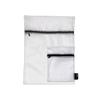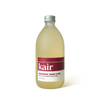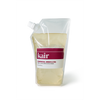How wash your wool blends at home - in partnership with KITRI
Eyeing up wearing your favourite wool blend jumper (our current favourite is KITRI's best-selling Lorna sweater) but unsure how to wash it at home? We’ve got you covered. It's not only possible to wash wool blends at home, but actually much better than going to the dry cleaner, which involves exposure to a destructive substance known as PERC, a neurotoxin associated with profound social and environmental hazards. Before you reach for the detergent, though, check the label that comes with your garment. It's as important to pay attention to the fabric content as to the care instructions themselves (if you’re unsure about these, check out our guide on decoding laundry care symbols): once you know what your garment’s made of, you can easily learn the most effective way to care for it. Read on for our cheat sheet on how to care for your wool blends at home.
Check the fabric content
Once you’ve identified wool as a key component, be sure to check the other percentages too. KITRI's Lorna pink wool alpaca sweater, for example, is 15% wool, 15% alpaca, 35% acrylic, 35% nylon. Wool blends like these, as well as wool-like synthetics, should all be cared for like wool. Examples of wool yarns include sheep, lamb, alpaca, pashmina, angora, mohair and camel hair. A wool-like synthetic is simply any synthetic made to resemble wool, like acrylic and nylon. If your garment contains a mixture of fibres, as above, follow the instructions for the more delicate fabric. So with KITRI's alpaca blend knit, the alpaca takes precedence over the other materials.
Should I wash it?
This is a very common question, and the answer’s yes! It might be tempting to dry clean wool, but that can flatten the yarns and make them dull, while also often failing to remove odour or stains. Washing wool not only preserves and stimulates the natural oils, or lanolin, in the yarns themselves, it also gives the garment as a whole a naturally fresh look and feel. So cast aside your wool-washing worries, and wash with confidence! How often you wash it depends on the specific wool blend, but in most cases, we recommend only every 7-10 wears. This is because wool blends contain self-regulating fibres which need less frequent laundering than other fabrics. You can remove any unpleasant odours with a light airing, as well as with a spritz of our lovely refreshing Finishing Spray.
Machine wash
While some care labels might instruct you to hand wash your wool garments to protect the seams or other sewn details, it’s a myth that wool must be hand washed - the advice isn’t for the sake of the fabric, and even garments with a 100% natural fibre content can usually be machine washed. Just be sure to select the wool or hand wash cycle, and always use a mesh laundry bag. Avoid biologicial detergents containing enzymes - which will break down the natural protein in the wool and reduce its lifespan - and instead choose our specifically formulated Wool, Silk & Delicates Wash. The machine should never be more than half-full, but feel free to include lightly soiled cottons and synthetics. Wool fibres can be at risk of felting (becoming matted and shrink) when washed - it's high heat mixed with a fast spin cycle that's the culprit here. With a low temperature, and slow spin cycle, you have nothing to fear (check out our piece on mastering the wool wash for more tips). Don't forget to take your garment out of the drum immediately after washing to reduce wrinkling and creasing.
Hand washing
If your wool blends are embellished, embroidered, beaded or sequinned, wash by hand in tepid water (30ºC - check out our step-by-step guide if you’re unsure of the method). As always with delicate, natural fibres, opt for our Wool, Silk & Delicates Wash, and be sure to let your garment soak in the water for 30 minutes before rinsing and gently squeezing out excess water. Reshape it if necessary while damp, then leave to dry on a flat surface. Avoid tumble dryers, as well as direct heat sources like sunlight or radiators, at all costs, as these can damage and shrink the fibres. If you want to speed up the drying process, simply roll it gently in a clean towel, then spritz with some Finishing Spray.


















